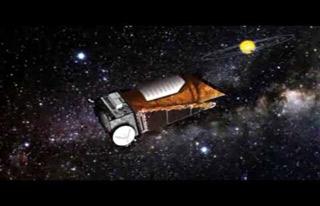
NASA's Kepler space observatory.
MOFFETT FIELD, CALIFORNIA (BNS): Scientists, with the help of Kepler space telescope, recently announced the detection of stellar oscillations, or ‘starquakes’, that would yield new insights about the size, age and evolution of stars.
The results were presented Tuesday at a news conference at Aarhus University in Denmark by scientists representing the Kepler Asteroseismic Science Consortium (KASC). The team studied thousands of stars observed by Kepler.
"Using the unparalleled data provided by Kepler, KASC scientists are quite literally revolutionising our understanding of stars and their structures," Douglas Hudgins, Kepler Program Scientist at NASA Headquarters in Washington, was quoted as saying in a NASA news report.
The Kepler chorus could help pin down the properties of planets, predict the future of our own sun and solve century-old stellar mysteries.
Analysis of stellar oscillations is similar to how seismologists study earthquakes to probe the Earth's interior. This branch of science is called astroseismology.
As an example of what asteroseismology can reveal, the researchers offered up a star called KIC 11026764.
By studying its pulses, scientists have learned more about this star than they know about virtually any star in the universe aside from the sun.
Researchers determined, for example, that KIC 11026764 is 5.94 billion years old and is roughly twice the size of the sun. KIC 11026764 will continue to grow, eventually transforming into a red giant. The oscillations reveal that this star is powered by hydrogen fusion in a thin shell around a helium-rich core, the report added.
"We are just about to enter a new area in stellar astrophysics. Kepler provides us with data of such good quality that they will change our view of how stars work in detail," said Thomas Kallinger, lead author on a study of red giant stars and postdoctoral fellow at the Universities of British Columbia and Vienna.
Scientists also reported on the star RR Lyrae. It has been studied for more than 100 years as the first member of an important class of stars used to measure cosmological distances. The brightness of the star oscillates within a well-known period of about 13.5 hours, researchers said. Yet during that period, other small, cyclic changes in amplitude occur- behaviour known as the Blazhko effect.
The effect has puzzled astronomers for decades, but Kepler data may have yielded a clue to its origin, researchers said. Kepler observations revealed an additional oscillation period that had never been previously detected. The oscillation occurs with a time scale twice as long as the 13.5-hour period. The Kepler data indicates the doubling is linked to the Blazhko effect.
Kepler was launched in March 2009. It was designed to discover Earth-size planets orbiting other stars. The spacecraft uses a huge digital camera, known as a photometer, to continuously monitor the brightness of more than 150,000 stars in its field of view as it orbits around the sun.
Kepler searches for distant worlds by looking for "transits," when a planet passes in front of a star, briefly causing it to dim. The amount of dimming reveals the size of the planet compared to the size of the star.
 Previous Article
Previous Article Next Article
Next Article












The Indian Air Force, in its flight trials evaluation report submitted before the Defence Ministry l..
view articleAn insight into the Medium Multi-Role Combat Aircraft competition...
view articleSky enthusiasts can now spot the International Space Station (ISS) commanded by Indian-American astr..
view article